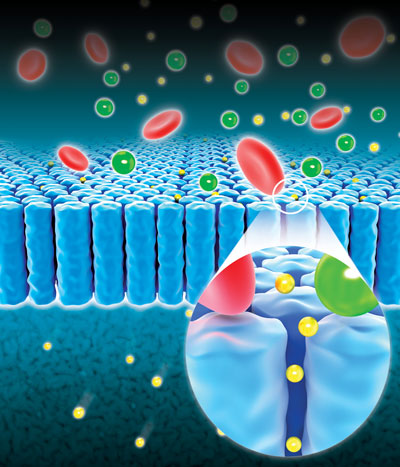| Posted: Aug 24, 2012 | |
Unique nanosieves with straight sub-10 nm nanopores |
|
| (Nanowerk Spotlight) Micro- and nanoporous materials can widely be found in nature, be it zeolite minerals, cell membranes, or diatom skeletons. Researchers are developing artificial analogues of such materials, i.e. nanoporous materials, for industrial applications in areas such as catalysis, water purification, environmental clean-up, molecular separation and proton exchange membranes for fuel cells. For instance, separation of complex biological fluids can particularly benefit from – sometimes chemically functionalized – nanosieves since many bioanalytical problems in proteomics or medical diagnostics cannot be solved with conventional separation technologies. | |
| For the successful commercialization of nanosieves in various industries, their fabrication process should be simple, cost-effective and mass-producible. However, most of the existing fabrication processes are expensive; cannot be implemented on a large scale; and require special and complex steps. | |
| Manufacturing nanosieves with straight nanopores is still challenging, especially when the pore size is less than 10 nm. Ion track etching and anodizing method are the most successful fabrication methods, but they also show difficulties in making nanosieves with sub-10 nm nanopores. | |
| Researchers in Korea have now developed a novel material and fabrication technique that allows easy fabrication of nanosieves with sub-10 nm nanopores with straight pore-structure. With it, controlling the pore size from sub-nm to 5 nm becomes very easy. | |
| Reporting their findings in a recent edition of Advanced Materials ("Use of a Columnar Metal Thin Film as a Nanosieve with Sub-10 nm Pores"), a team led by Prof. Jun-Bo Yoon, Director of the 3D Micro-Nano Structures Laboratory at KAIST and Dr. Dae-Sik Lee, Principle Researcher at the IT Convergence Technology Research Laboratory at ETRI, propose a convenient method for nanosieve fabrication that relies only on general physical vapor deposition (PVD) and ion milling processes. | |
 |
|
| Schematic showing the columnar-structured nanosieve with its straight-opened nanopores. (Image: Dong-Hoon Choi, KAIST) | |
| These findings are based on the fact that a common feature of thin-films formed by PVD is a columnar structure. What is new is the team's demonstration that the numerous voids naturally formed among the close-packed columnar grains can be used as nanopores to separate molecules with different sizes. | |
| "PVD and ion milling are very conventional processes that have a long history of application in the semiconductor industry where it is frequently used to form the metal electrode or dielectric layer," Dong-Hoon Choi, a PhD candidate in Yoon's group and first author of the paper, tells Nanowerk. "Whereas other researchers have employed additional processes to make nanopores, we focused on the numerous voids naturally formed among grains during PVD. Our proposed fabrication process is extremely handy, cost-effective and suitable for industrial-scale mass production." | |
| Choi explains that this novel nanosieve fabrication process basically consists of three steps: forming a nanoporous thin film using PVD such as evaporation or sputtering; bulk etching a substrate to make a free-standing membrane; and conventional ion milling to etch the bottom of the nanosieve, where initially-grown nanopores are present. | |
| "The growth mechanism of the columnar structure in PVD-fabricated thin-films can be briefly explained by two major phenomena" says Choi: "Limited surface diffusion and an atomic shadowing effect." | |
| He elaborates that, at the beginning of conventional PVD processes, atoms cannot be deposited uniformly due to their limited surface diffusion; thus they form islands or polycrystalline islands. "This non-uniform deposition results in a rough surface, and the vapored atoms are captured by higher protruded points, a phenomenon known as an atomic shadowing effect. Therefore, as the PVD process progresses, the higher protruded points continuously grow up to become columnar grains, whereas the areas shadowed by the protruded points become nanopores." | |
| Choi points out that selectivity and permeation speed are critical properties of nanosieves. "Owing to the nature of the columnar structure with vertically well-aligned grains, our nanosieves have numerous straight pores which run from top to bottom – an ideal structure for a nanosieve." | |
| In their experiments, the team tested the outstanding performance of their nanosieves. | |
| Robust mechanical strength: The nanosieve endured pressure up to 2 atm. | |
| Highly selective permeation: Free Alexa Fluor? 488 dyes freely permeated through the nanosieve, whereas human serum albumin and immunoglobulin-γ were completely blocked. | |
| Extremely fast permeation speed: The fluorescence intensity of free Alexa Fluor? 488 dyes permeated through the columnar nanosieve was saturated within as little as 30 seconds, but the intensity through a commercialized nanosieve was not saturated for 10 minutes. | |
| The researchers are now working on refining their process in order to get well-ordered columnar grains and nanopores. | |
| "Actually" says Choi, "although the nanosieve pores are straight and have a distribution of minimal diameter, the pores are not ordered well and their shape varies due to the columnar grains with different shapes. So, in order to achieve well-ordered nanopores, we will study the growth behavior of columnar grains in depth and develop a new deposition process to get well-ordered columnar grains." | |
 By
Michael
Berger
– Michael is author of three books by the Royal Society of Chemistry:
Nano-Society: Pushing the Boundaries of Technology,
Nanotechnology: The Future is Tiny, and
Nanoengineering: The Skills and Tools Making Technology Invisible
Copyright ©
Nanowerk LLC
By
Michael
Berger
– Michael is author of three books by the Royal Society of Chemistry:
Nano-Society: Pushing the Boundaries of Technology,
Nanotechnology: The Future is Tiny, and
Nanoengineering: The Skills and Tools Making Technology Invisible
Copyright ©
Nanowerk LLC
|
|
|
Become a Spotlight guest author! Join our large and growing group of guest contributors. Have you just published a scientific paper or have other exciting developments to share with the nanotechnology community? Here is how to publish on nanowerk.com. |
|
